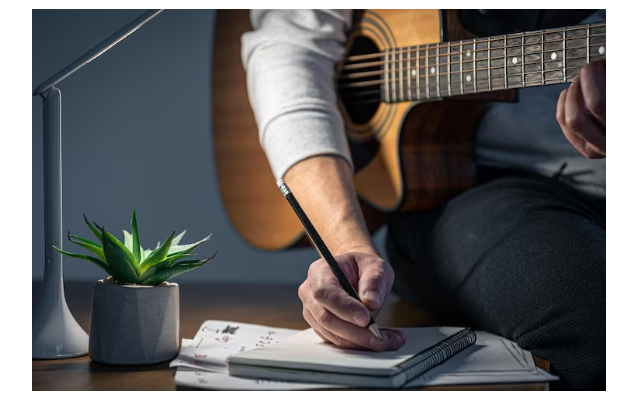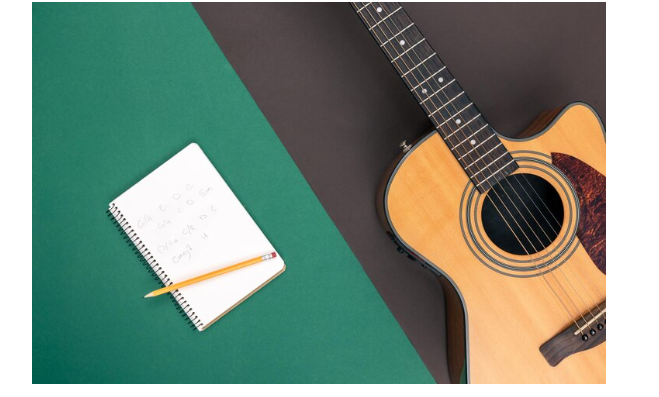The string of guitar is arguably one of the instrument's most crucial parts. They make the guitar's sound and significantly impact the instrument's tone and how it can be played. This article will dive deep into the significance of guitar strings, discussing their makeup, structure, and impact on the instrument's tone and usability.

How Many Strings Does A Guitar Have?
A typical guitar has six strings. However, there are also guitars with seven, eight, nine, ten, or even twelve strings, but these are less common.
The earliest known guitar-like instruments had four strings, while later versions had five, six, seven, eight, or even nine strings. However, the six-string guitar became the most popular configuration in the 20th century, and it remains the standard for most guitar music today.
The six-string guitar first gained popularity in the 19th century, as it was favored by classical guitarists and became a popular instrument in the emerging genres of blues and jazz.
The guitar strings are made using the following process:
- Typically, nylon or steel is used for guitar strings. Classical instruments have nylon strings because of their soft, soothing tone. The tone of most other instruments is louder and more mechanical because they use steel strings.
- A high-carbon steel center is usually covered with other metals, like nickel, copper, or stainless steel, to create steel strings. Metals are selected for their specific qualities, like tonal quality or resistance to rust.
- The nylon material is stretched and coiled when making nylon threads to achieve the required diameter and stress.
- String width, tension, and twisting are just some variables to consider when shopping for a set.

Thickness
Guitar strings vary in width (or gauge) depending on their girth. However, playing thicker strings can be more challenging because of the deeper, louder tone they create. However, thinner strings are simpler to play and create a livelier, more treble-heavy tone.
Tension
The quantity of energy needed to extend a guitar string to a specific tune is known as the string's tension. Strings with a higher tension are more challenging to perform but have a richer, more sustained tone. While strings with a lower pitch are simpler to play, they may produce a feeble or sparse tone.
Winding
A thin wire is commonly used to wind guitar strings around the centre of the string. The string's sound and flexibility can be altered by how it is wound. The sound of round-wound strings is brilliant and steely, while the tone of flat-wound strings is softer and gentler, but they can be more difficult to perform.
Why do Guitar Strings Matter?
The tone and usability of an instrument are profoundly affected by its strings. Some of the most salient justifications for instrument strings:
Sound
The guitar's strings are the instrument's main music generator. The strings' construction, dimensions, tension, and twisting affect the guitar's sound. For instance, the sound produced by bulkier strings is typically broader and more robust, while the sound produced by shorter strings is typically livelier and more treble-heavy.
Playability
The strings also have a significant impact on the guitar's flexibility. The string's diameter, tension, and twisting contribute to how challenging or simple the instrument performs. Thinner, lower-tension strings are typically simpler to play than their thicker, higher-tension counterparts.
Durability
The strings on a guitar eventually break and need to be changed. Compared to low-quality, inexpensive strings, high-quality ones tend to last longer and sound better. Spending more initially on high-quality strings means spending less overall on repairs.
Choice Based On Preference
A guitarist's taste will determine the string gauge they use. Others prefer a softer, more subdued tone, while some players prefer a sharp, steely sound. A guitarist's preference for strings may also be informed by the genre(s) of music they perform.
Varieties of Guitar Strings
Various guitar strings are accessible, each with its own set of qualities and functions. Nylon, steel, and treated strings are the three most common kinds. Each category is broken down below:
Nylon Chords
Classical instruments have nylon strings because of their soft, soothing tone. Nylon material is stretched and coiled to achieve the required width and stress. Classical strings, also known as classical nylon strings, can range in thickness from 1 (the narrowest) to 6 (the thickest), with 1 being the thinnest and 6 being the heaviest.
Steel Chords
Acoustic, electric, and bass instruments use steel strings instead of nylon. Strings made from metals like nickel-plated steel, stainless steel, and brass create a tone that is livelier and more metallic than that of nylon strings. Labels on steel strings will usually include a figure between them .010 and.012 correspond to the string's width in thousandths of an inch.
Coated Strings
Coated strings are special steel strings with a fine polymer coating applied to them to prevent rusting and lengthen their useful life. Both acoustic and electric guitars can be purchased with coated strings; these strings are typically labelled as "coated" or "polymer-coated," Some players claim that they produce a slightly muted sound and feel different to play than uncoated strings.
Half-round Strings
Speciality Strings, such as flat wound and half-round strings, are also available and are typically used by jazz musicians in addition to the standard set of strings. Flatwound or half-round strings are often used because of the softer, warmer tone they create compared to round-wound strings.
Ultimately, a guitarist's choice of strings will come down to individual taste, performing the technique, and instrument model.


How to Remember Guitar String Order?
For novices looking to pick up the guitar, learning the chord arrangement is a crucial first step. Learning the titles of the strings and the tones they produce is essential for accurate setting and performing. In this article, we'll talk about some good ways to recall the instrument chord arrangement.
Recognizing and Identifying String Pitch Names and Names
It is essential to know the titles and frequencies of the strings before we talk about how to memorise their sequence. Named from lightest to heaviest, the six strings of a conventional guitar are as follows:
- E (thinnest string): B, G, D and A
- E (thickest string)
There is a particular tone associated with each thread. Each string's tone when played freely (with no frets depressed) is: E, B, G, D, A and E
Keep the String Order in Mind!
Some helpful memory techniques for learning guitar chord arrangement are provided below.
Mnemonics
Mnemonics are a powerful tool for remembering the string sequence. Mnemonics are devices that associate one piece of knowledge with another in order to make it more memorable. Some common mnemonics for recalling the string's sequential position are as follows:
- The End Is Nigh, Eddie Ate Dynamite (EADGBE)
- The Ears of Elephants and Donkeys Expand. (EADGBE)
- You Can Get Fat Just By Eating (EADGBE)
Eventually, the law catches up with every acid dealer. (EADGBE)
Repetition
The arrangement of the strings can also be remembered through repetition. Say the titles of the strings and the frequencies they correlate to over and over again until you can do it automatically. You can also strengthen your recall by practising the chords in sequence while gazing at the instrument.
Visualisation
One more useful technique for recalling the string sequence is to visualise it. Put the instrument in front of your mental image and close your eyes. Imagine a string and the tone it would produce. You can also mark the names and pitches of the guitar strings in a schematic.
Songs
Songs are a great musical aid for remembering the string arrangement. Songs like "Smoke on the Water" by Deep Purple (which employs the sounds E, G, and A) and "Seven Nation Army" by The White Stripes both feature tunes that incorporate guitar string notes. (which uses the notes E and G).
Acronyms
Acronyms are a form of memory device in which the initial letter of each member of a series is used to form a new term. Some instances are as follows:
- Inevitably, all apples will rot. (EADGBE)
- Alcoholic Easter Bunnies Are A Thing (EBGDAE)

Advice for Learning Guitar
One of the best ways to learn a new skill or indulge in a new pastime is by teaching oneself to perform the guitar at home. However, without instruction it can be difficult to get started or figure out how to advance. In this article, we'll discuss ways to improve your exercise regimen at home so you can learn guitar more quickly.
Plan Ahead
It is essential to have clear aspirations before beginning guitar lessons. Playing a specific tune or perfecting a certain skill are just two examples of such objectives. Having defined objectives will keep you enthusiastic and concentrated on your progress.
Get back to the Fundamentals
It is best to begin guitar lessons with the fundamentals. This entails mastering the proper grip, tuning, and foundational melodies and patterns for playing the guitar. Learning the fundamentals first will set you up for success and speed up your learning curve.
Get Help from the Internet
If you want to study guitar on your own time, you can find a wealth of information online. Some examples are guitar tablature (TAB) webpages, internet classes, and educational films. You can use these tools to study theory, hone your skills, and receive constructive criticism.
Consistent Exercise
Practising on a consistent basis is crucial when learning an instrument at home, such as the guitar. Consistent exercise is the best way to create muscle memory, refine your skill, and fortify your self-assurance. If you want to get better at an instrument, you need to put in some time practising it every day.
Figure out a Method of Practice
To make advancement on the instrument, it is essential to establish a productive exercise regimen. Scales, harmonies, and melodies can all be part of this routine's pre-performance preparation. The methods or skills you wish to hone should also be your primary concern. Try out various methods of exercise until you discover what works best for you.
Get Involved with Virtual Groups
The ability to interact with other guitarists and receive constructive criticism is a major benefit of participating in online music groups. Social media platforms, message boards, and guitar-centric web pages all host online groups. Support, inspiration, and constructive criticism on your performance can all be found in these groups.
Put Yourself on Tape
Keeping track of your development and pinpointing your weak spots can be facilitated by listening to recordings of yourself performing guitar. You can capture your performance using your phone or another audio device, then listen to the tape to figure out what you need to work on.
Play Around with Various Formats
Learning guitar allows you to experiment with many various musical genres. If you want to learn more about music and hone your skills, try performing a different style, such as the blues, rock, or jazz. You can use this to further refine your own personal approach to the instrument.

How does Superprof Assist with Guitar Learning?
Guitar pupils can find competent instructors to work with them on Superprof. Guitar classes from Superprof can be customised to meet your individual requirements. If you want to study a specific genre or are at a specific talent level, you can find an instructor who excels in that area. The educators at Superprof are dedicated to the growth and development of their pupils. They can give you constructive criticism on your performance and moral support to help you push through difficult times.















